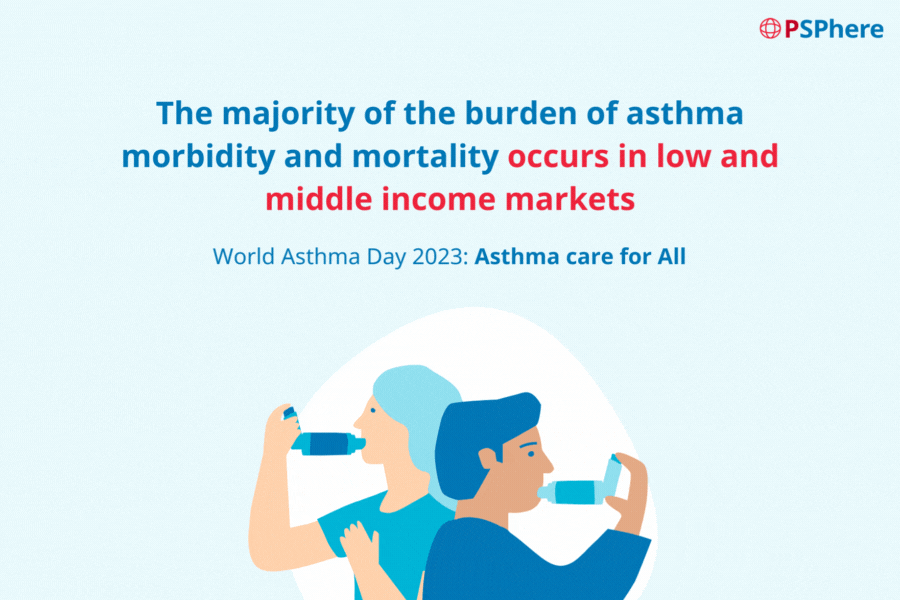Improving Diagnosis and Management of Asthma in Asia Pacific

Asthma is a common chronic respiratory disease that causes difficulty breathing due to inflammation of the airways. Asthma symptoms include dry cough, wheezing, chest tightness, and shortness of breath. These symptoms are intermittent and are often worse at night or during exercise.
The triggers of Asthma vary from one to another, but common allergens can include viral infections, dust mites, air pollution, particles in the air, pollens, and animal fur. Some medicines such as aspirin (acetylsalicylic acid), nonsteroidal anti-inflammatory drugs, and medicines known as beta blockers can also trigger asthma.
In this article, we will explore some of the challenges faced by asthma patients and discuss potential solutions and support programs to help improve their quality of life.
Current State of Asthma
The World Health Organization estimated that asthma affected 262 million people in 2019 and caused 455,000 deaths globally. Most asthma-related deaths occur in low- and lower-middle-income markets where under-diagnosis and under-treatment are a challenge.
Although the symptoms can be managed with medications like Seretide (fluticasone/salmeterol) and changes in their lifestyle, asthma patients face several challenges that can impact their daily lives both physically and mentally.
The Asthma Insights and Reality in Asia-Pacific study was conducted in 2000 across eight regions in Asia Pacific. The study found that among 3,207 asthma patients, 51.4 percent of respondents reported experiencing daytime symptoms while 44.3 percent reported sleep disturbance during the preceding four weeks. In addition, 43.6 percent of the respondents had been hospitalized or made unscheduled emergency visits to other healthcare facilities for treatment of asthma during the previous 12 months.
Challenges for Asthma Patients in Asia
In addition to the challenges that physician-diagnosed asthma patients are facing, there are also challenges for another group of patients who are misdiagnosed, under, or over-diagnosed. The latter group of patients may face such problems due to the lack of awareness about asthma, incomplete symptoms and medical history, and other underlying conditions.
There is evidence that asthma is widely misdiagnosed and leads to significant risks to patients. They may be prescribed medication that can cause unnecessary side effects. Without proper management of their symptoms, asthma can significantly impact an individual’s quality of life and increase the risk of severe asthma attacks.
Based on a study published in 2017, in Asia Pacific, asthma affects approximately 17.5 million people. The prevalence of asthma in the adolescent age group is estimated to vary from 0.7 to 11.9 percent. Considering the rapid urbanization which leads to lifestyle changes and an increase in pollution, the prevalence is expected to increase in various markets. Only the minority of people with asthma in Asia achieved good control.
Private and public sectors in Asia are actively providing support for asthma patients. For example, in Taiwan, The National Bureau of Health Promotion, under the Department of Health, sponsored a national asthma education program in 1999 for school nurses nationwide. This program aimed to improve the knowledge and confidence of school nurses in providing asthma care for schoolchildren.
In Singapore, the Singapore National Asthma Program was established in 2001 to promote preventive treatment and improve asthma control. Additionally, Asthma Malaysia, a patient-advocacy platform, was established in 2017 to provide reliable and credible online resources for asthma patients and increase awareness of asthma in Malaysia.
Patient-Centric Approach to Asthma Control
Asthma control requires a long-term and comprehensive approach, combining both behavioral and pharmacological aspects. Patients can have better outcomes when complementing the focus on disease severity and symptoms with individual patient characteristics, preferences, and lifestyles.
Taking DKSH as an example, the focus of our patient support programs (PSPs) is to address the gaps and problems patients experience and provide a holistic approach using technology and expertise on the ground to offer value-added services to solve them.
PSPhere is a technology platform that helps to manage patient relationships and benefits can help patients keep records of symptoms and medication, which HCPs can use when considering treatment options. Our front-line Patient Support Specialists can help increase patient understanding about symptom management and trigger avoidance and can lead to improved self-management and adherence to treatment plans.
One of the examples where PSPhere is implemented to support asthma patients is in Australia. We have been working with nurses throughout the market since 2019, to support more than 1,900 patients with asthma. Under this program, our nurses engage with patients in various ways including home visits, virtual visits, text messages, and e-mail messages. They provide training on how to administer medication and symptom management, as well as reminders about appointments and follow-up care.
By working closely with clients, patients, their families, and healthcare providers, we believe that significant progress can be made toward the diagnosis and management of asthma. Reach out to us to learn more about our PSP solutions.
Sources:
- https://aafa.org/asthma/asthma-triggers-causes/
- https://www.who.int/news-room/fact-sheets/detail/asthma#:~:text=Asthma%20affected%20an%20estimated%20262,help%20to%20reduce%20asthma%20symptoms.
- https://www.who.int/news-room/fact-sheets/detail/asthma#:~:text=Asthma%20affected%20an%20estimated%20262,help%20to%20reduce%20asthma%20symptoms.
- https://www.who.int/news-room/fact-sheets/detail/asthma#:~:text=Asthma%20affected%20an%20estimated%20262,help%20to%20reduce%20asthma%20symptoms.
- https://www.jacionline.org/article/S0091-6749(02)91292-3/fulltext
- https://breathe.ersjournals.com/content/15/1/e20
- https://www.nature.com/articles/npjpcrm201689
- https://www.researchgate.net/publication/262150337_Epidemiology_of_adult_asthma_in_Asia_Toward_a_better_understanding/link/549290a40cf209fc7e9f6e12/download
- https://www.nature.com/articles/npjpcrm201689
- https://apjai-journal.org/wp-content/uploads/2018/01/2IncreasingAsthmaCareVol24No4December2006P183.pdf
- https://www.primarycarepages.sg/schemes-and-programmes/singapore-national-asthma-programme
- https://asthmamalaysia.org/